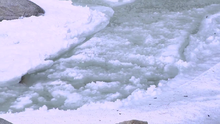Frazil-Eis

Frazil-Eis ist eine Ansammlung loser, zufällig orientierter nadelförmiger Eiskristalle in flüssigem Wasser. Es liegt in der Form von Slush vor und erscheint von der Oberfläche des Wassers aus gesehen etwas ölig. Es bildet sich sporadisch in offenem, turbulentem, unterkühltem Wasser, was bedeutet, dass es sich normalerweise in Flüssen, Seen und Ozeanen in klaren Nächten bei Lufttemperaturen unter −6 °C bildet.

Frazil-Eis ist das erste Stadium der Entstehung von Meereis.
Siehe auch
Literatur
- Frank Lindemann: Sedimente im arktischen Meereis – Eintrag, Charakterisierung und Quantifizierung. = Sediments in arctic sea ice – entrainment, charakterization and quantification (= Berichte zur Polarforschung 283, ISSN 0176-5027). Alfred-Wegener-Institut für Polar- und Meeresforschung, Bremerhaven 1998, (online (PDF; 3,47 MB)).
Auf dieser Seite verwendete Medien
Autor/Urheber: Brocken Inaglory, Lizenz: CC BY-SA 4.0
Nilas Sea Ice Buffin Bay Arctic. In calm water, the first sea ice to form on the surface is a skim of separate crystals which initially are in the form of tiny discs, floating flat on the surface and of diameter less than 2-3 mm. Each disc has its c-axis vertical and grows outwards laterally.
At a certain point such a disc shape becomes unstable, and the growing isolated crystals take on a hexagonal, stellar form, with long fragile arms stretching out over the surface. These crystals also have their c-axis vertical.
The dendritic arms are very fragile, and soon break off, leaving a mixture of discs and arm fragments. With any kind of turbulence in the water, these fragments break up further into random-shaped small crystals which form a suspension of increasing density in the surface water, an ice type called frazil or grease ice.
In quiet conditions the frazil crystals soon freeze together to form a continuous thin sheet of young ice; in its early stages, when it is still transparent, it is called nilas. When only a few centimetres thick this is transparent (dark nilas) but as the ice grows thicker the nilas takes on a grey and finally a white appearance.Frazil ice flowing in Yosemite Creek

